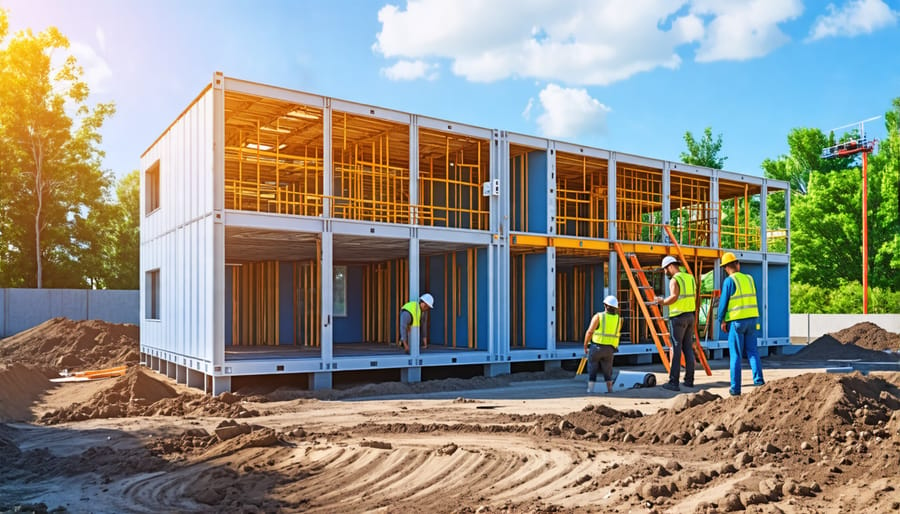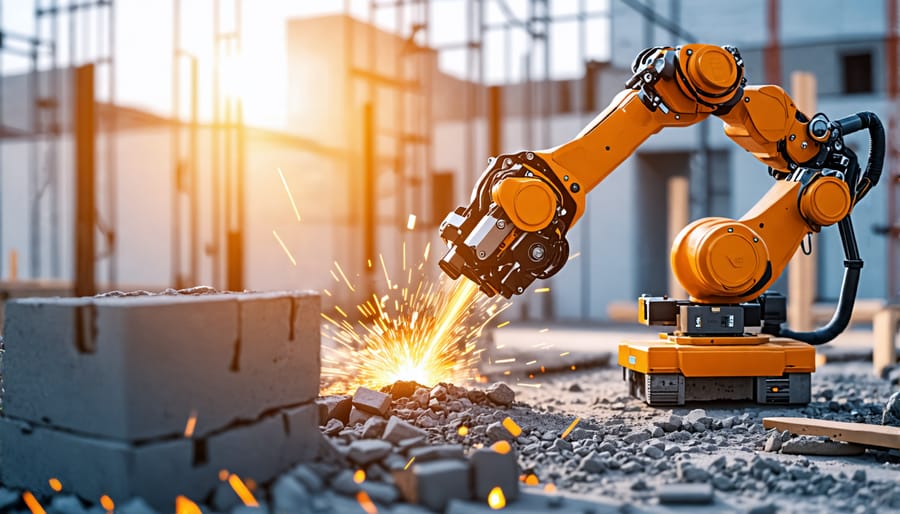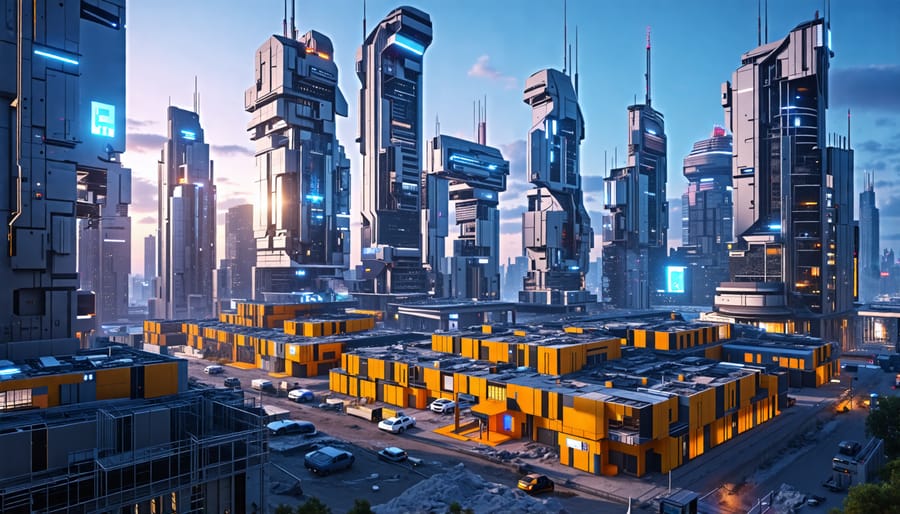Discover how innovative construction methods are revolutionizing the industry, from 3D printing and modular construction to sustainable materials and construction innovations like robotics and smart technology. These cutting-edge techniques are transforming the way we build, offering benefits such as increased efficiency, reduced waste, improved safety, and enhanced sustainability. As the construction sector evolves, embracing these groundbreaking methods is crucial for staying competitive and meeting the demands of a rapidly changing world.
3D Printing
Benefits of 3D Printing in Construction
3D printing is revolutionizing the construction industry by offering numerous benefits that traditional methods cannot match. One of the most significant advantages is the reduction of waste materials. With 3D printing, projects use only the necessary amount of materials, minimizing excess and decreasing environmental impact. This technology also allows for increased design flexibility, enabling architects and engineers to create complex, customized structures that would be challenging or impossible to build using conventional techniques. By streamlining the construction process, 3D printing can significantly shorten project timelines, saving both time and money. Additionally, this innovative method enhances safety on construction sites by reducing the need for manual labor in hazardous situations. As 3D printing continues to advance, it has the potential to transform the way we approach construction, leading to more efficient, sustainable, and inventive building practices that will shape the future of the industry.
Real-World Examples
Several notable projects have successfully harnessed the power of 3D printing technology in construction. Dubai’s Office of the Future, completed in just 17 days, showcases the speed and efficiency of this innovative method. In the Netherlands, the MX3D Bridge demonstrates the potential for intricate, customizable designs using 3D-printed steel. The world’s first 3D-printed community in Mexico, developed by ICON, provides affordable housing solutions, highlighting the technology’s social impact. These projects not only push the boundaries of architectural design but also offer a glimpse into the future of construction, where 3D printing can revolutionize the way we build, leading to faster, more sustainable, and cost-effective projects that cater to the evolving needs of our communities.

Modular and Prefabricated Construction

How It Works
Offsite construction, also known as prefabrication or modular construction, is an innovative method that involves constructing building components in a controlled factory environment before transporting them to the final construction site for assembly. This process begins with the design phase, where architects and engineers create detailed plans and specifications for each component, taking into account the unique requirements of the project.
Once the designs are finalized, the components are manufactured in a factory setting using advanced machinery and skilled labor. This controlled environment allows for greater precision, consistency, and quality control compared to traditional on-site construction methods. The factory setting also enables the use of innovative materials and techniques that may not be feasible or cost-effective in a conventional construction site.
After the components are manufactured, they are carefully transported to the construction site and assembled according to the predetermined plans. This assembly process is typically faster and more efficient than traditional construction methods, as the components are designed to fit together seamlessly. The modular nature of the components also allows for greater flexibility in the design and layout of the final structure.
By constructing components offsite, this innovative method reduces waste, minimizes site disruption, and enhances worker safety. It also allows for parallel progress on-site and in the factory, potentially shortening the overall construction timeline and reducing costs.
Advantages of Modular Construction
Modular construction offers numerous advantages over traditional building methods, making it an attractive choice for many projects. One of the most significant benefits is improved quality control. By constructing modules in a controlled factory environment, builders can maintain strict quality standards, reduce the risk of errors, and ensure consistent results. This approach also allows for more efficient use of materials and minimizes waste.
Another key advantage is reduced construction time. With modules being built simultaneously off-site, on-site preparation and foundation work can occur concurrently, significantly shortening the overall project timeline. This faster turnaround time translates to earlier occupancy and quicker returns on investment for developers and property owners.
Modular construction also minimizes site disruption, as the majority of the construction process takes place off-site. This aspect is particularly beneficial in urban areas or sites with limited space, as it reduces noise, dust, and traffic congestion. The reduced on-site activity also enhances safety for workers and the surrounding community.
Furthermore, modular construction offers greater flexibility and adaptability. Modules can be easily customized to meet specific design requirements and can be disassembled, relocated, or repurposed as needed, making them ideal for temporary structures or evolving needs.
Sustainable Building Materials
Examples of Sustainable Materials
Sustainable materials are revolutionizing the construction industry, offering eco-friendly alternatives to traditional building components. Recycled steel, derived from demolished structures and industrial waste, reduces the need for virgin materials and minimizes the environmental impact of steel production. Bamboo, a rapidly renewable resource, exhibits impressive strength-to-weight ratio and versatility, making it an attractive choice for flooring, scaffolding, and structural elements. Hempcrete, a composite of hemp hurds and lime, provides excellent insulation properties and regulates humidity, creating healthier indoor environments. Ferrock, a concrete alternative made from recycled steel dust and silica, boasts superior strength and carbon dioxide absorption capabilities, effectively reducing the carbon footprint of construction projects. These innovative materials not only contribute to the sustainability of the built environment but also inspire architects and engineers to explore novel design possibilities. As the demand for green building solutions grows, the adoption of recycled steel, bamboo, hempcrete, and ferrock is expected to accelerate, driving the industry towards a more sustainable future. By incorporating these materials into their projects, construction professionals can demonstrate their commitment to environmental stewardship while delivering high-quality, durable, and aesthetically pleasing structures.
Environmental Impact
Innovative construction methods not only streamline processes but also significantly reduce the environmental impact of building projects. By employing sustainable materials such as recycled steel, low-carbon concrete, and engineered wood products, these methods minimize the carbon footprint associated with traditional construction. For instance, 3D printing techniques optimize material usage, reducing waste and transportation emissions. Similarly, modular construction allows for more efficient use of resources and minimizes on-site waste generation. The use of locally sourced, renewable, and recyclable materials further contributes to the overall sustainability of these innovative approaches, making them an attractive choice for eco-conscious construction professionals and clients alike.
Robotics and Automation

Types of Construction Robots
Construction robots are revolutionizing the industry by automating various tasks, improving efficiency, and enhancing safety on job sites. One notable example is the SAM100 (Semi-Automated Mason) bricklaying robot, which can lay up to 3,000 bricks per day, significantly outpacing human workers. This robot reduces the physical strain on masons and allows for faster completion of projects.
Welding robots, such as those developed by Yaskawa and FANUC, are also making their mark in the construction industry. These robots can perform precise, consistent welds in a fraction of the time it would take a human welder, while minimizing the risk of errors and injuries. Additionally, robots like the Husky UGV (Unmanned Ground Vehicle) are being used for site inspections and surveying, capturing detailed data and images of construction sites to aid in project planning and progress monitoring.
Other innovative construction robots include the Tybot, which automates the process of tying rebar, and the Doxel AI robot, which uses artificial intelligence to monitor construction progress and identify potential issues. As these technologies continue to advance, the construction industry can expect to see increased productivity, improved quality control, and safer working conditions on job sites.
Impact on Efficiency and Safety
Robotics is revolutionizing the construction industry, significantly improving efficiency, precision, and safety on job sites. Autonomous robots can work tirelessly around the clock, executing tasks with unparalleled accuracy and consistency. This not only accelerates project timelines but also reduces the likelihood of costly errors. Moreover, robots can handle hazardous tasks, such as demolition or working at heights, minimizing the risk of worker injuries. By leveraging advanced sensors and AI, these machines can navigate complex environments, adapt to changing conditions, and collaborate seamlessly with human workers. As robotics continues to advance, it promises to reshape the construction landscape, driving productivity, quality, and safety to new heights.
Smart Construction Technology
Connected Job Sites
The Internet of Things (IoT) has revolutionized the construction industry by enabling connected job sites. IoT devices and sensors, strategically placed throughout the construction site, allow for real-time monitoring and data collection. These devices track various aspects of the project, such as equipment performance, material usage, and environmental conditions. By collecting and analyzing this data, project managers can make informed decisions, optimize resource allocation, and identify potential issues before they escalate. Real-time monitoring also enhances safety by alerting workers to hazardous situations and enabling remote control of equipment in high-risk areas. The data generated by IoT devices provides valuable insights into construction processes, leading to improved efficiency, reduced costs, and better project outcomes. As the construction industry continues to embrace digital transformation, connected job sites powered by IoT technology will become increasingly common, driving innovation and reshaping the way projects are managed and executed.
Predictive Analytics
Predictive analytics, powered by AI and machine learning, is transforming the construction industry by enabling proactive issue detection and prevention. By analyzing vast amounts of data from various sources, such as sensors, project management software, and historical records, these advanced algorithms can identify patterns and predict potential problems before they occur. This allows construction teams to optimize resource allocation, minimize delays, and mitigate risks, ultimately leading to improved project outcomes. Predictive analytics also helps in forecasting project timelines, costs, and quality, empowering decision-makers to make informed choices and ensure successful project delivery.
Conclusion
In conclusion, the construction industry is on the cusp of a revolutionary transformation, driven by innovative methods and technologies. From 3D printing and modular construction to sustainable materials, robotics, and smart tech, these advancements are reshaping how we design, build, and maintain structures. As construction professionals, it is crucial to stay informed about these developments and adapt to the changing landscape of the industry.
By embracing these innovations, we can unlock significant benefits, including increased efficiency, reduced costs, improved safety, and enhanced sustainability. However, it is equally important to approach these new methods with a critical eye, carefully evaluating their suitability for each project and ensuring proper implementation.
As the construction industry continues to evolve, it is essential for professionals to invest in continuous learning and collaboration. By staying updated on the latest trends, sharing knowledge, and working together to overcome challenges, we can harness the full potential of these innovative construction methods and build a better, more resilient future for our industry.

